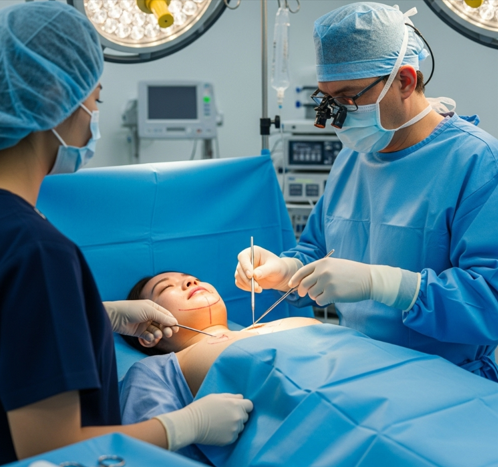Treatment Overview
Areola Reduction in Korea is a cosmetic surgical procedure designed to reduce the diameter and improve the shape of enlarged or stretched areolas, creating a balanced and aesthetically pleasing breast appearance. This procedure is often performed in combination with a breast lift to enhance overall breast contour and symmetry.
Korean plastic surgeons are internationally recognized for their precision, artistry, and minimally invasive techniques, which ensure natural-looking results and minimal scarring.
Purpose & Benefits
The main purpose of areola reduction is to correct disproportionate areola size, improve breast aesthetics, and restore confidence.
Key benefits include:
- Smaller, proportionate areolas that match breast size and shape
- Enhanced overall breast symmetry
- Improved self-confidence and body image
- Minimally visible scarring due to advanced Korean techniques
- Can be combined with breast lift or augmentation for optimal contour
Ideal Candidates
Areola reduction is suitable for individuals who:
- Have enlarged or stretched areolas due to genetics, pregnancy, breastfeeding, or aging
- Desire improved breast symmetry and appearance
- Are undergoing breast lift or other breast contouring procedures
- Are in good overall health and have realistic expectations
- Wish to restore proportionate and aesthetically pleasing breasts
Possible Risks & Complications
Although areola reduction is a safe procedure, potential risks include:
- Temporary swelling, bruising, or tenderness
- Minor scarring along incision lines
- Changes in nipple or areola sensation (usually temporary)
- Infection or delayed healing
- Minor asymmetry between areolas
- Rare complications related to anesthesia
Surgical Techniques Used
Korean surgeons use advanced techniques to achieve precise and natural-looking results:
- Circumferential Incision Method: Removes excess areolar skin around the edge, reducing diameter while preserving nipple function.
- Central Wedge Technique: Corrects significant stretching by excising a wedge-shaped portion for uniform contour.
- Combination with Breast Lift: Allows simultaneous elevation of the breast for harmonious proportions.
- Minimally Invasive Approach: Incisions are placed strategically along the areolar border to minimize visible scars.
- 3D Planning: Surgeons ensure symmetry and proportionality with precise pre-operative markings.
Recovery & Aftercare
Recovery is carefully managed in Korean clinics to ensure safe and effective results:
- Most patients can resume light daily activities within 3–5 days.
- Swelling and bruising typically resolve within 1–2 weeks.
- Avoid pressure on the breasts or strenuous exercise for 3–4 weeks.
- Follow-up appointments monitor healing, scar formation, and areola symmetry.
- Scar management and post-operative care, including topical treatments, are provided for optimal outcomes.
Results & Longevity
Results are immediate, with final areola shape and size visible as swelling subsides within 2–4 weeks.
- Areola reduction results are long-lasting, especially when combined with breast lift or augmentation for proportionate aesthetics.
- Korean techniques ensure natural contour, symmetry, minimal scarring, and preservation of nipple function.
- Proper post-operative care and maintenance prolong results.
Treatment Process in Korea
Korea is a preferred destination for areola reduction due to its expertise, precision techniques, and patient-centered care:
- Comprehensive Consultation: Surgeons evaluate areola size, breast shape, skin quality, and patient goals.
- Customized Surgical Plan: Technique selection (circumferential or wedge excision) is tailored to the patient’s anatomy and aesthetic desires.
- Advanced Surgical Methods: Korean surgeons utilize minimally invasive approaches, precise suturing, and 3D planning for optimal symmetry.
- Combination with Breast Lift or Augmentation: Many patients undergo simultaneous procedures to achieve proportional and harmonious breasts.
- Medical Tourism Support: English-speaking coordinators, recovery accommodations, and structured follow-up care are standard for international patients.
- Emphasis on Natural Aesthetics: Surgeons focus on symmetry, proportionality, and minimal visible scarring, achieving a natural look consistent with Korean beauty standards.
Cost Range
Areola reduction in Korea is competitively priced while offering world-class surgical precision:
- Typical Price Range: ₩2,500,000 – ₩5,500,000 KRW
(Approx. $1,900 – $4,200 USD)
Factors Affecting Cost:
- Technique used (circumferential vs. wedge excision)
- Combination with breast lift or augmentation
- Surgeon’s experience and clinic reputation
- Hospital or operating facility fees
Additional Costs:
- Pre-operative assessments and tests: ₩100,000 – ₩300,000 KRW ($75 – $230 USD)
- Post-operative medications and scar management: ₩150,000 – ₩400,000 KRW ($115 – $300 USD)
- Compression garments and post-op support: ₩50,000 – ₩150,000 KRW ($40 – $115 USD)
Popular Clinics
Top Korean clinics for areola reduction include:
- Banobagi Plastic Surgery Clinic – specializes in minimally invasive techniques with natural results
- JK Plastic Surgery Center – internationally accredited, experienced in breast and areola procedures
- View Plastic Surgery Hospital – offers precise 3D planning for optimal symmetry
- ID Hospital Seoul – high-volume center for combined breast lift and areola reduction
- Regen Plastic Surgery – expert in achieving proportionate, natural-looking results




